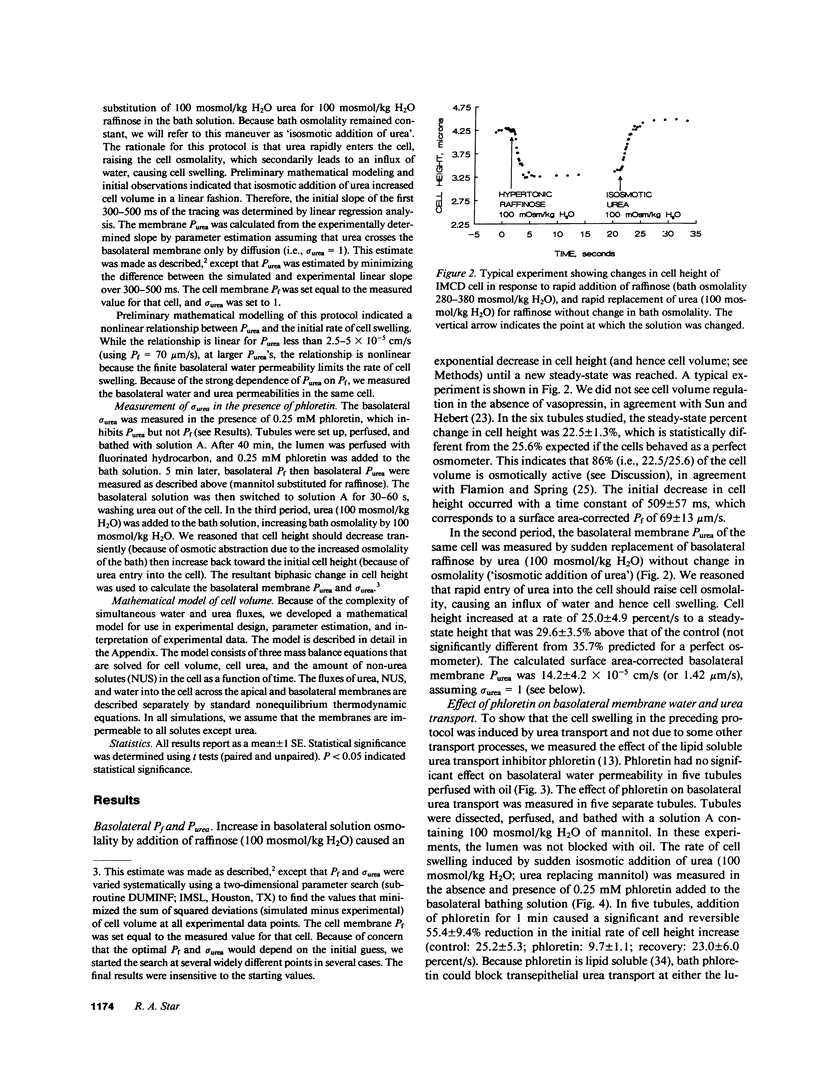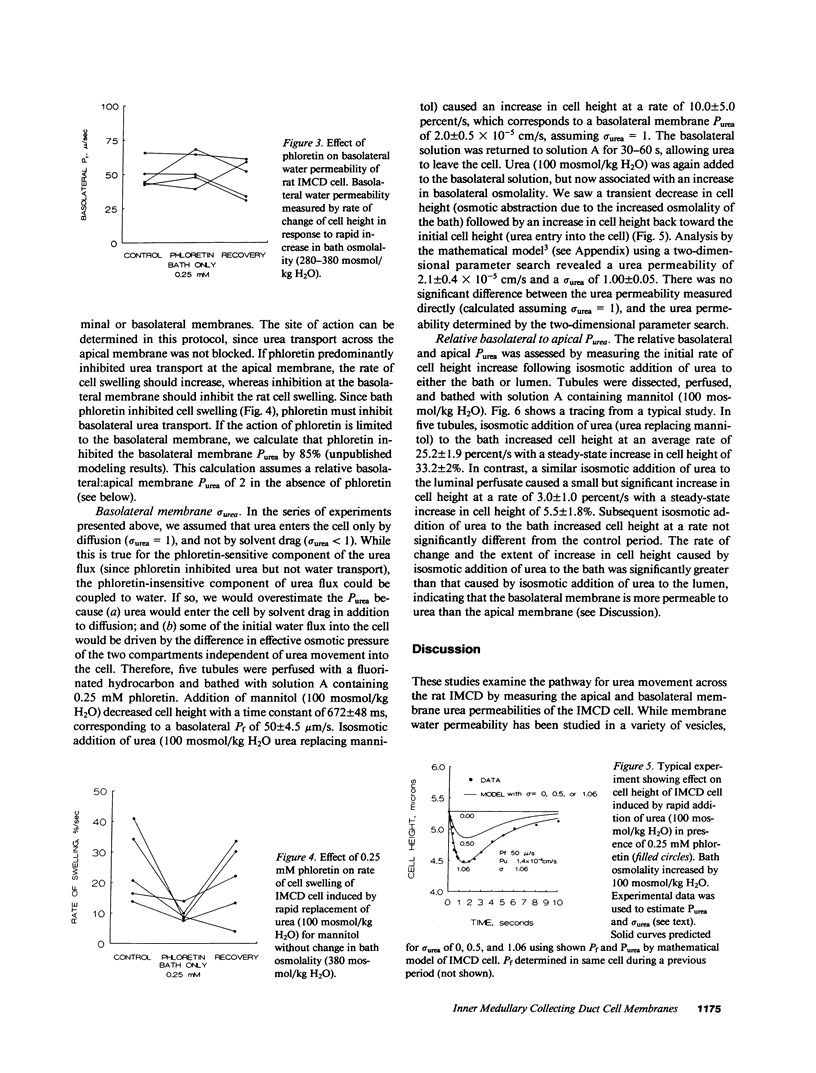Abstract
Urea diffuses across the terminal inner medullary collecting duct (IMCD) via a facilitated transport pathway. To examine the mechanism of transcellular urea transport, membrane-apparent urea (Purea) and osmotic water (Pf) permeabilities of IMCD cells were measured by quantitative light microscopy in isolated IMCD-2 tubules perfused in the absence of vasopressin. Basolateral membrane Pf, determined by addition of raffinose to the bath, was 69 microns/s. Basolateral membrane Purea, determined by substituting urea for raffinose without change in osmolality, was 14 X 10(-5) cm/s. Bath phloretin inhibited basolateral Purea by 85% without a significant effect on Pf. The basolateral reflection coefficient for urea, determined by addition of urea in the presence of phloretin, was 1.0. These results indicate that urea crosses the basolateral membrane by diffusion, and not by solvent drag. In perfused tubules, the rate of cell swelling following substitution of urea for mannitol was significantly greater with bath than lumen changes. After correcting for membrane surface area, the basolateral membrane was twofold more permeable than the apical membrane. Conclusions: (a) in the absence of vasopressin, urea permeation across the IMCD cell is limited by the apical membrane; (b) the basolateral membrane contains a phloretin-sensitive urea transporter; (c) transepithelial urea transport occurs by movement of urea through the IMCD cell.
Full text
PDF






Selected References
These references are in PubMed. This may not be the complete list of references from this article.
- BERLINER R. W., LEVINSKY N. G., DAVIDSON D. G., EDEN M. Dilution and concentration of the urine and the action of antidiuretic hormone. Am J Med. 1958 May;24(5):730–744. doi: 10.1016/0002-9343(58)90377-2. [DOI] [PubMed] [Google Scholar]
- Burg M. B. Perfusion of isolated renal tubules. Yale J Biol Med. 1972 Jun-Aug;45(3-4):321–326. [PMC free article] [PubMed] [Google Scholar]
- Chen P. Y., Pearce D., Verkman A. S. Membrane water and solute permeability determined quantitatively by self-quenching of an entrapped fluorophore. Biochemistry. 1988 Jul 26;27(15):5713–5718. doi: 10.1021/bi00415a048. [DOI] [PubMed] [Google Scholar]
- Chou C. L., Knepper M. A. Inhibition of urea transport in inner medullary collecting duct by phloretin and urea analogues. Am J Physiol. 1989 Sep;257(3 Pt 2):F359–F365. doi: 10.1152/ajprenal.1989.257.3.F359. [DOI] [PubMed] [Google Scholar]
- Clapp W. L., Madsen K. M., Verlander J. W., Tisher C. C. Morphologic heterogeneity along the rat inner medullary collecting duct. Lab Invest. 1989 Feb;60(2):219–230. [PubMed] [Google Scholar]
- Guggino W. B., Oberleithner H., Giebisch G. Relationship between cell volume and ion transport in the early distal tubule of the Amphiuma kidney. J Gen Physiol. 1985 Jul;86(1):31–58. doi: 10.1085/jgp.86.1.31. [DOI] [PMC free article] [PubMed] [Google Scholar]
- Imai M., Taniguchi J., Yoshitomi K. Osmotic work across inner medullary collecting duct accomplished by difference in reflection coefficients for urea and NaCl. Pflugers Arch. 1988 Oct;412(6):557–567. doi: 10.1007/BF00583755. [DOI] [PubMed] [Google Scholar]
- Kachadorian W. A., Sariban-Sohraby S., Spring K. R. Regulation of water permeability in toad urinary bladder at two barriers. Am J Physiol. 1985 Feb;248(2 Pt 2):F260–F265. doi: 10.1152/ajprenal.1985.248.2.F260. [DOI] [PubMed] [Google Scholar]
- Kachadorian W. A., Spring K. R., Shinowara N. L., Muller J., Palaia T. A., DiScala V. A. Effects of serosal hypertonicity on water permeability in toad urinary bladder. Am J Physiol. 1990 May;258(5 Pt 1):C871–C878. doi: 10.1152/ajpcell.1990.258.5.C871. [DOI] [PubMed] [Google Scholar]
- Knepper M. A., Roch-Ramel F. Pathways of urea transport in the mammalian kidney. Kidney Int. 1987 Feb;31(2):629–633. doi: 10.1038/ki.1987.44. [DOI] [PubMed] [Google Scholar]
- Knepper M. A., Sands J. M., Chou C. L. Independence of urea and water transport in rat inner medullary collecting duct. Am J Physiol. 1989 Apr;256(4 Pt 2):F610–F621. doi: 10.1152/ajprenal.1989.256.4.F610. [DOI] [PubMed] [Google Scholar]
- Kondo Y., Imai M. Effects of glutaraldehyde fixation on renal tubular function. I. Preservation of vasopressin-stimulated water and urea pathways in rat papillary collecting duct. Pflugers Arch. 1987 May;408(5):479–483. doi: 10.1007/BF00585072. [DOI] [PubMed] [Google Scholar]
- MAFFLY R. H., HAYS R. M., LAMDIN E., LEAF A. The effect of neurohypophyseal hormones on the permeability of the toad bladder to urea. J Clin Invest. 1960 Apr;39:630–641. doi: 10.1172/JCI104078. [DOI] [PMC free article] [PubMed] [Google Scholar]
- Macey R. I., Farmer R. E. Inhibition of water and solute permeability in human red cells. Biochim Biophys Acta. 1970 Jul 7;211(1):104–106. doi: 10.1016/0005-2736(70)90130-6. [DOI] [PubMed] [Google Scholar]
- Macey R. I. Transport of water and urea in red blood cells. Am J Physiol. 1984 Mar;246(3 Pt 1):C195–C203. doi: 10.1152/ajpcell.1984.246.3.C195. [DOI] [PubMed] [Google Scholar]
- Madsen K. M., Clapp W. L., Verlander J. W. Structure and function of the inner medullary collecting duct. Kidney Int. 1988 Oct;34(4):441–454. doi: 10.1038/ki.1988.201. [DOI] [PubMed] [Google Scholar]
- Marsh D. J., Jensen P. K., Spring K. R. Computer-based determination of size and shape in living cells. J Microsc. 1985 Mar;137(Pt 3):281–292. doi: 10.1111/j.1365-2818.1985.tb02585.x. [DOI] [PubMed] [Google Scholar]
- Morgan T., Berliner R. W. Permeability of the loop of Henle, vasa recta, and collecting duct to water, urea, and sodium. Am J Physiol. 1968 Jul;215(1):108–115. doi: 10.1152/ajplegacy.1968.215.1.108. [DOI] [PubMed] [Google Scholar]
- Rapoport J., Mills J. W., Franki N., Church H. H., Hays R. M. Autoradiographic studies of solute transport across the toad bladder. Kidney Int. 1985 May;27(5):726–730. doi: 10.1038/ki.1985.72. [DOI] [PubMed] [Google Scholar]
- Rocha A. S., Kokko J. P. Permeability of medullary nephron segments to urea and water: Effect of vasopressin. Kidney Int. 1974 Dec;6(6):379–387. doi: 10.1038/ki.1974.123. [DOI] [PubMed] [Google Scholar]
- Sands J. M., Knepper M. A. Urea permeability of mammalian inner medullary collecting duct system and papillary surface epithelium. J Clin Invest. 1987 Jan;79(1):138–147. doi: 10.1172/JCI112774. [DOI] [PMC free article] [PubMed] [Google Scholar]
- Sands J. M., Nonoguchi H., Knepper M. A. Vasopressin effects on urea and H2O transport in inner medullary collecting duct subsegments. Am J Physiol. 1987 Nov;253(5 Pt 2):F823–F832. doi: 10.1152/ajprenal.1987.253.5.F823. [DOI] [PubMed] [Google Scholar]
- Star R. A. Basolateral membrane sodium-independent Cl-/HCO3- exchanger in rat inner medullary collecting duct cell. J Clin Invest. 1990 Jun;85(6):1959–1966. doi: 10.1172/JCI114659. [DOI] [PMC free article] [PubMed] [Google Scholar]
- Star R. A., Nonoguchi H., Balaban R., Knepper M. A. Calcium and cyclic adenosine monophosphate as second messengers for vasopressin in the rat inner medullary collecting duct. J Clin Invest. 1988 Jun;81(6):1879–1888. doi: 10.1172/JCI113534. [DOI] [PMC free article] [PubMed] [Google Scholar]
- Strange K., Spring K. R. Cell membrane water permeability of rabbit cortical collecting duct. J Membr Biol. 1987;96(1):27–43. doi: 10.1007/BF01869332. [DOI] [PubMed] [Google Scholar]
- Strange K., Spring K. R. Methods for imaging renal tubule cells. Kidney Int. 1986 Aug;30(2):192–200. doi: 10.1038/ki.1986.171. [DOI] [PubMed] [Google Scholar]
- Sun A., Hebert S. C. Rapid hypertonic cell volume regulation in the perfused inner medullary collecting duct. Kidney Int. 1989 Nov;36(5):831–842. doi: 10.1038/ki.1989.269. [DOI] [PubMed] [Google Scholar]
- Verkman A. S. Mechanisms and regulation of water permeability in renal epithelia. Am J Physiol. 1989 Nov;257(5 Pt 1):C837–C850. doi: 10.1152/ajpcell.1989.257.5.C837. [DOI] [PubMed] [Google Scholar]
- Verkman A. S. The quenching of an intramembrane fluorescent probe. A method to study the binding and permeation of phloretin through bilayers. Biochim Biophys Acta. 1980 Jul;599(2):370–379. doi: 10.1016/0005-2736(80)90184-4. [DOI] [PubMed] [Google Scholar]
- Yousef L. W., Macey R. I. A method to distinguish between pore and carrier kinetics applied to urea transport across the erythrocyte membrane. Biochim Biophys Acta. 1989 Sep 18;984(3):281–288. doi: 10.1016/0005-2736(89)90294-0. [DOI] [PubMed] [Google Scholar]


